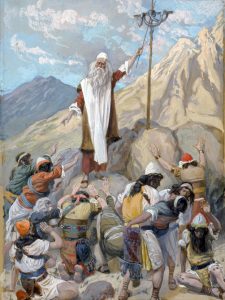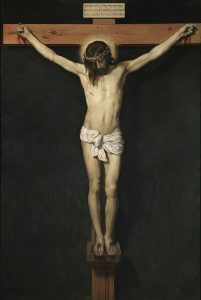Equipping Members of the Next Generation of Christians to Defend Their Faith and to Embrace a Biblical Worldview, Part 8
The “condition of man” is not what modern man thinks it is.
—Francis Schaeffer—
Everybody has the privilege of going to heaven God’s way or going to hell their own way.
—Donald Grey Barnhouse1—
Key point: Efforts to make the gospel more attractive may actually make it less attractive—because in some ways, the element that gives the gospel its ability to offend is the very same one that God uses to draw people to Himself.
An expanded version of this article is available here.
You can find links to all the articles in this series here.
One of the most powerful accounts in the Old Testament is found in 2 Kings 5. Naaman, the commander of the Aramean (Syrian) military force, was an effective leader of the army in his charge; but he had leprosy, and the prognosis was poor. Go here to read the account of his healing from in 2 Kings 5:1-19 in the New Living Translation.
Naaman’s Quest
Let’s dig into the account from 2 Kings to learn a few things from Naaman’s experience about following a prophet’s instructions to acquire physical healing. As we do, we also will gain insights about following God’s directions for attaining spiritual healing and a right relationship with the Lord. Here we go!
Second Kings 5:1-19 (cited above) tells us that Naaman, commander of the Syrian army, was well respected in Syria. Ben Hadad II was the King of Syria at the time, and Naaman, as Syria’s chief military officer, was the number two man in the nation. He had power, prestige, influence, and wealth—but he also had leprosy.
God sovereignly used a young woman from Israel who had been placed in the service of Naaman’s wife to point Naaman to an opportunity to be healed. “I wish my master would go to see the prophet in Samaria,” the servant girl declared in verse 3. “He would heal him of his leprosy.”
Of course, she was speaking of the prophet Elisha. Naaman informed the king of Syria what the servant girl had said, and the king sent him, not to Elisha, but to King Joram of Israel with lavish gifts and a letter requesting that Naaman be healed. King Joram was incredulous and tore his clothes. Syria was an enemy, not an ally! Was the king of Syria trying to pick a fight with him by asking him to do the impossible?
Elisha, the “man of God,” heard what had happened and, through a message, encouraged the king to calm down. “Send Naaman my way,” he essentially said, “and he will see that Israel is a place where a true spokesman for God lives.”
This was the man the servant in Naaman’s household wanted her master to see! Naaman rode “with his horses and chariots” to Elisha’s doorstep and waited—but Elisha didn’t even have the decency to come out to talk to Naaman personally! Instead, he sent a messenger with instructions for Naaman to dip himself seven times in the Jordan River, washing himself each time. After that, he would be healed.
The Syrian military officer stormed off in anger and disgust.
- He was angry Elisha had sent a messenger rather than meeting with him personally.
- He was upset that the prophet didn’t wave his hand over the leprous spots on his body, praying to his God for Naaman to be healed.
- Furthermore, he was frustrated beyond words that he’d been told to wash in the muddy Jordan when the water in the rivers in Damascus in Syria came from the snow-covered mountains nearby.2 These rivers, in contrast to the Jordan, were clean.
Greatly offended, Naaman was furious and “went away in a rage.”
The words of Naaman’s officers in 2 Kings 5:13 are some of the most powerful and poignant in all of the Old Testament. Their advice overflows with wisdom. They said to Naaman, “Sir, if the prophet had told you to do something very difficult, wouldn’t you have done it? So you should certainly obey him when he says simply, ‘Go and wash and be cured!’” In other words, what did Naaman have to lose?
So Naaman went to the Jordan River and washed himself in it seven times, just as Elisha, through a messenger, had directed him. After completing the assignment, Naaman saw that his leprosy was gone! His skin had become like that of a young child.
This experience was not lost on the Syrian military officer, because he now understood that Israel’s God was the one true God. He offered Elisha a gift, but Elisha turned down the offer. Naaman pledged that henceforth he would offer sacrifices only to Israel’s God. While Naaman then asked forgiveness for bowing before the Syrian God when he escorted the king, his master, into the pagan temple in Syria, Elisha didn’t make an issue of it. We might surmise that Elisha realized Naaman was a new believer in the one true God and had a lot to learn. Yet Elisha surely understood this Syrian had learned a great deal already. “Go in peace,” Elisha said; and Naaman, now whole, departed for home.
Offended!
Naaman’s healing is a picture of salvation—especially as it relates to being offended by the truth and having to swallow one’s pride. In the last two installments in our series on apologetics, we have considered that Jesus is the only way to God and that the Christian gospel never could have originated in human imaginations. Foundational to both of those articles is the truth that if people only understood how terribly wicked they are, they also would recognize their complete inability to make themselves look good before God and their desperate need for a Savior. In the book that bears his name, the prophet Jeremiah, under the inspiration of the Holy Spirit, says it well.
“The human heart is the most deceitful of all things,
and desperately wicked.
Who really knows how bad it is?” (Jer. 17:9).
Here I want to explore a related theme, but one that still may not initially sound as if it belongs in an apologetics series. We will consider the reality that the gospel is offensive—inherently, on its own and by itself.
Previously, I have made this point in passing in more than one Word Foundations post (such as this article and this one). I was attempting to emphasize that efforts to attract people to Christianity and the church, as well as believers’ and churches’ attempts to refrain from offending non-Christians, while well-intentioned, may have the unintended consequence of watering down an unvarnished yet essential aspect of the gospel. Clearly, we never ought to offend people unnecessarily—but neither should we try to diminish the way in which the gospel necessarily offends. Yes, I contend that, to a certain extent and in a certain way, the gospel of Christ has to offend. Stay with me, and hear me out!
Consider Naaman’s healing as a picture of an individual’s receiving salvation in Christ. Here are several important observations.
- Naaman had to come to the God of Israel—the one and only true God—to be healed.
- Naaman had a bevy of expectations that he had to ditch before he could be healed. In other words, he had to come to God on God’s conditions, not his own.
- Naaman’s expectations were consistent with conventional human wisdom. He thought he deserved to hear the message of healing from the prophet personally, but not from the prophet’s messenger. He believed the prophet should have waved his hands and prayed over his leprous sores. And if he were going to have to wash in a river—for crying out loud—he at least ought to have been able to wash in a clean one!
- Elisha was concerned enough for Naaman to give him instructions to be healed, but he also was unimpressed with him—despite his status as an important military leader.3
- It was the content of the instructions that had to be respected and obeyed, regardless of the manner in which the message was delivered.
- Obeying the instructions required faith in the word of the prophet, God’s spokesman—so obeying actually required faith God.
- The instructions were simple; so simple, in fact, that they required Naaman to ditch not just his expectations, but also his pride.
- God’s way always requires a person to exercise humility. Pride is totally out of the picture. We see this following Naaman’s healing as well, in Elisha’s refusal to accept the gift—or the payment—the Syrian military commander offered.
All of this was offensive to Naaman—so much so that he was ready to walk away without being healed. His officers, however, talked him down from his anger and encouraged him to do what he’d been asked to do. What did he have to lose? Well, his pride; and that is the point!
What did Naaman have to lose? Well, his pride, and that is the point!
As D. L. Moody said of Naaman, “He lost his temper, then he lost his pride; then he lost his leprosy; that is generally the order in which proud rebellious sinners are converted.”4 While there are varying degrees of resistance to the gospel among sinners, it’s an indisputable fact that all sinners are proud and rebellious. Were they not, they wouldn’t be sinners!
Naaman lost his temper, then he lost his pride; then he lost his leprosy; that is generally the order in which proud rebellious sinners are converted.
—D. L. Moody—
Because Naaman met God on his conditions, he was healed; and God, not Naaman, got the glory for the miraculous change that occurred.
The Bronze Snake on a Pole Offers a Parallel Scenario
It’s both interesting and significant that Naaman’s healing is just one of many Old Testament pictures of the salvation Christ offers. The ark of Noah is another, and the bronze snake on a pole is yet another. Let’s consider the snake.

When the Israelites were making their way through the wilderness to the promised land, they grumbled and complained numerous times. In Numbers 21:4-9, the people had “set out from Mount Hor, taking the road to the Red Sea to go around the land of Edom.” (v. 4). Yet they “grew impatient with the long journey” (v. 4) and complained against Moses and God. No bread! No water! Terrible food! So the Lord disciplined His people by sending poisonous snakes among them. Many were bitten and many died—so the ailing people came to Moses and asked him to plead with the Lord for mercy. The Lord not only was merciful, but gracious as well. Yet He didn’t just heal everyone on the spot; He required something of them. What God required was so easy no one could take any credit for being healed, but it also was very difficult because the very act of obeying God meant admitting wrong and acknowledging utter helplessness and dependence on God for healing. The Lord told Moses to mount the image of a snake on a pole. “All who are bitten will live,” God declared, “if they simply look at it!” (v. 8). So Moses crafted a bronze snake and affixed it to a pole that he lifted up for the people to see, and all who had been bitten and looked at the snake were restored to health.
Again, God’s way was simple and difficult at the same time. Some welcomed it and lived while others were offended by it and died. And quite probably, a good many were offended at first; then, like the thief who was crucified next to Jesus, reconsidered and decided to take the remedy God had offered.
Centuries later, Jesus told Nicodemus, who had come to him by night to talk to him about spiritual things, “[A]s Moses lifted up the bronze snake on a pole in the wilderness, so the Son of Man must be lifted up, so that everyone who believes in him will have eternal life” (John 3:14-15; see context here).
The Shame of the Cross

Do you see the parallels between Naaman’s healing and an individual’s receiving Christ’s offer of salvation today? Do you see the parallels between the healings of those who looked at the snake in the the wilderness and those who look to Christ for forgiveness and eternal life? You should! Probably the bronze snake portrays the image of the cross more clearly than Naaman’s healing, but the similarities still are evident. Moreover, when we gaze upon the cross, we come to this unavoidable conclusion: The cross of Jesus Christ is especially offensive!
You see, the cross, or crucifixion, is the means by which Jesus shed His blood and was executed for human sin—a capital offense before God, one that demands eternal death as punishment. Because Jesus was the God-man who was innocent, His voluntary death could take place in one eternal moment, and it could become a substitute for the deaths that sinners themselves were supposed to die.
Jesus shed His blood and was executed for human sin—a capital offense before God, one that demands eternal death as punishment.
Jesus’ death, however, cannot be credited to any sinner’s account before God unless and until that sinner repents of sin, essentially admitting that he or she richly deserves all that Jesus endured. In fact, had Jesus not endured suffering and death, and if the sinner does not implore God to credit His death to his or her account, the sinner remains headed straight for hell.
Without question, the gospel is good news! Jesus did indeed bleed and die to pay the penalty for human sin on a Passover Friday. After that, He was buried; but early the following Sunday morning He was raised again to life, proving that God approved of His Son’s sacrifice.

This good news, however, can be seen as the good news it really is only against the backdrop of the utterly hopeless condition of humanity apart from Christ and His offer of salvation. Furthermore, to adequately defend the gospel—to effectively offer an apologetic for it—a Christian needs to understand its power to offend as well as to save. The truth is that, stripped of its ability to offend, the message of the gospel also is robbed of its power to save.
Stripped of its ability to offend, the message of the gospel also is robbed of its power to save.
Paul Authenticated the Gospel He Preached by Acknowledging its Capacity to Offend
Please reread what we have just said: Stripped of its ability to offend, the message of the gospel also is robbed of its power to save. The apostle Paul essentially said this in his letter to the churches in the province of Galatia. We’ll get to that specific statement in a moment, but first some background. False teachers had infiltrated the Galatian churches with the message that faith in Christ was insufficient for salvation, that a person also needed to follow Jewish regulations, including circumcision. “Oh foolish Galatians!” Paul wrote in what we now know as Galatians 3:1-5,

Who has cast an evil spell on you? For the meaning of Jesus Christ’s death was made as clear to you as if you had seen a picture of his death on the cross. 2 Let me ask you this one question: Did you receive the Holy Spirit by obeying the law of Moses? Of course not! You received the Spirit because you believed the message you heard about Christ. 3 How foolish can you be? After starting your new lives in the Spirit, why are you now trying to become perfect by your own human effort? 4 Have you experienced so much for nothing? Surely it was not in vain, was it?
5 I ask you again, does God give you the Holy Spirit and work miracles among you because you obey the law? Of course not! It is because you believe the message you heard about Christ.
Paul went on to emphasize later in the letter that even though some people claimed that he himself taught that obeying the Jewish laws and rituals was necessary for salvation, his actual message was that salvation comes through reliance on Christ alone. In Galatians 5:11, the apostle asked, “Dear brothers and sisters, if I were still preaching that you must be circumcised—as some say I do—why am I still being persecuted?” Then he declared, “If I no longer were preaching salvation through the cross of Christ, no one would be offended.”
If I no longer were preaching salvation through the cross of Christ, no one would be offended.
—the apostle Paul in Galatians 5:11—
There are other passages in the Bible as well that refer to the gospel’s ability to offend—and to save. Here are three more.
The Bottom Line
Never should we intentionally try to offend, but neither should we ever try to alter the gospel to make it more attractive.
Were we to do that, we would misrepresent the very reason Christ came to save us—a truth people must understand in order to be saved.
Copyright © 2018 by B. Nathaniel Sullivan. All rights reserved.
Unless otherwise indicated, all Bible passages in the above article have been taken from the Holy Bible, New Living Translation, copyright © 1996, 2004, 2007 by Tyndale House Foundation. Used by permission of Tyndale House Publishers, Inc., Carol Stream, Illinois 60188. All rights reserved.
top image: Elisha Refusing Gifts, 1630, by Pieter DeGrebber
image credit: Paul’s World
Notes:
1Donald Grey Barnhouse, quoted in Warren Wiersbe, The Bible Exposition Commentary, Old Testament: Joshua—Esther, (Colorado Springs, CO: David C. Cook, 2003), 522.
2Wiersbe, 598.
3Thomas L. Constable, “2 Kings,” in The Bible Knowledge Commentary, Old Testament, John F. Walvoord and Roy B. Zuck, eds., (Wheaton, IL: Victor Books, 1985), 547.
4D. L. Moody, quoted in Wiersbe, 523.
5Wiersbe, 521.

Be First to Comment